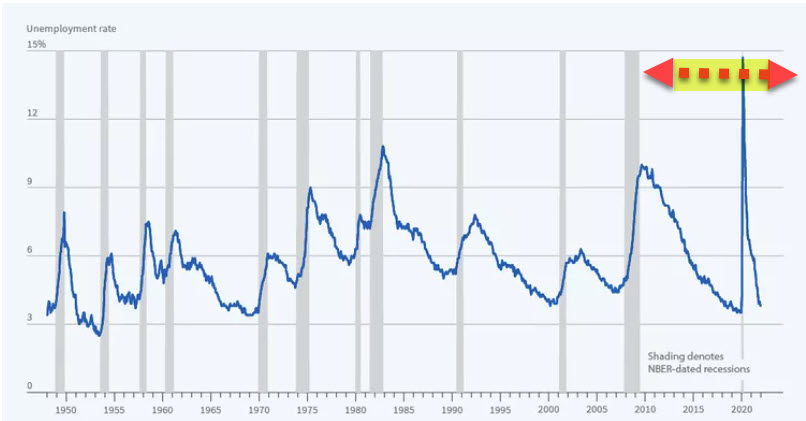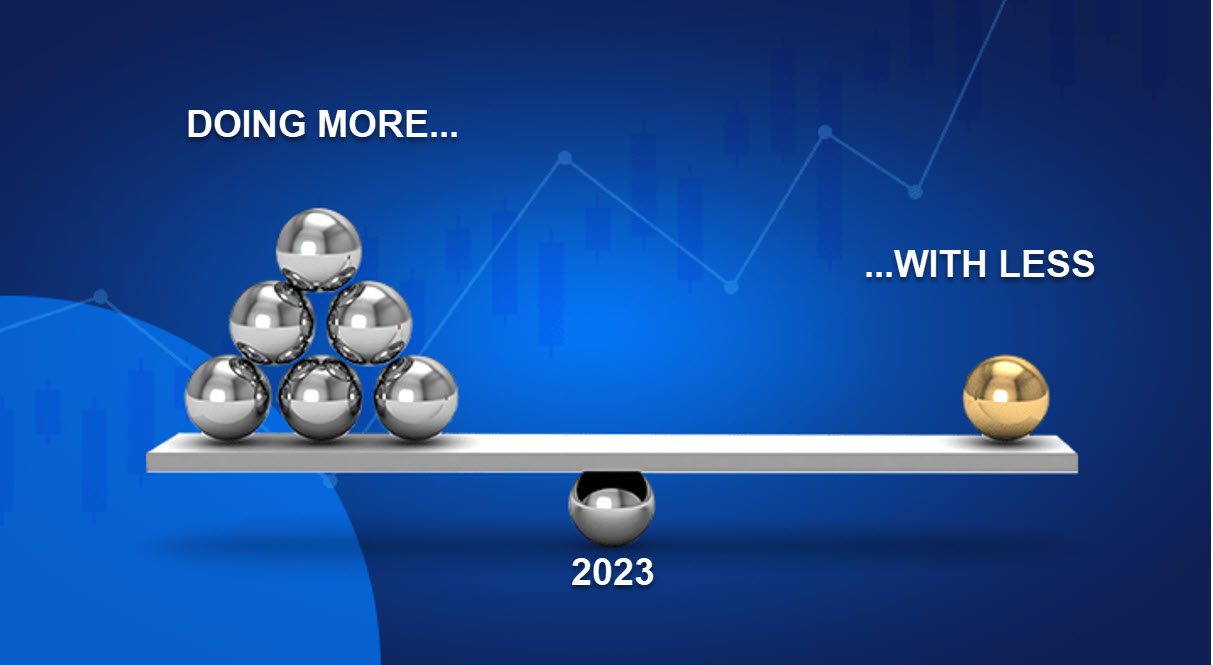“You wouldn’t believe the offer I just received to go work for [major tech company name omitted]” said one of my good friends who happens to be a stellar salesperson.
“That’s great but why would they be hiring so many people right now and offering to pay so much?” I responded with a rather perplexed look on my face.
“I don’t know but I would be a fool to turn it down” he said.
The timeframe of our conversation was early in 2022 when the stock market and technology sectors were already showing signs of weakness. And based on the historic length of the last business cycle, minus COVID, most people could clearly see that we were now past the second phase of a business cycle (peak) and heading well into the third phase (contraction). Seeing all of this and having NOT slept through my economics classes in college, I was beginning to wonder if most of the people in Silicon Valley did…assuming they studied economics at all. And this was why I was so perplexed by what I was hearing from my friend…and many others for that matter in the tech space.
Many of these tech companies had rapidly increased their workforce by over 50% since 2019 with some companies like Amazon (106%) and Meta (103%) over doubling their size in a very short period of time. So, when headlines recently broke about massive layoffs in tech sector, I thought about my friend and then wondered where amongst all of these brilliant minds was just one person who should have asked, “What happens to all of these new hires when the economy contracts?”
Bueller…Bueller…
The historic average for a business cycle in the US is around 5.5 years. The last recession concluded in 2009 so even factoring in a few off-years for COVID, it shouldn’t take a rocket scientist to know we were long overdue. Add to this the recent record spending spree over the past few years in Washington that pumped 5 trillion dollars into a 25 trillion-dollar economy, and it wasn’t hard to see too much money chasing too few goods…which means inflation. In short, if the economic cycle was the match, the Federal government was a whole can of sterno being poured into a grill and anybody who has done this up close knows the consequences of this logic in facial hair alone.

To wit, I live near a luxury mall and said many times to my wife over the past few years “Honey, have you noticed the really long line each day outside of the Louis Vuitton store and how most of those kids look like they have never worked a day in their life?” It took the Fed long enough to finally get hit in the face with a two-by-four about this growing problem we were all apparently seeing outside the beltway which led to a record rise in interest rates to rapidly slow down the economy and help tame inflation. And for many people this led to one conclusion…
The party is now over!
But apparently recent layoffs weren’t the only casualty of this economic ignorance – for it may have been the first of many dominoes yet to fall. Just last week two major banks dealing with Crypo (Silvergate) and Tech Companies (Silicon Valley Bank – SVB) failed within 48 hours. SVB is now the second largest bank failure in US history. Here is another classic lesson in economics 101. First, the government pumps trillions of dollars into the economy and your bank’s non-diversified base of depositors make record deposits. You then convert the majority of those deposits into longer-term debt (bonds) that although they seem safe, it deprives you of short-term liquidity. Your client base then publicly suffers large equity losses and is overvalued. They need money now, but you cannot provide it without taking a huge loss. Why? Because the value of the bonds you bought are inversely related to interest rates…which once again, had to go up to help tame run-away inflation. So, your only option is to sell your bonds early to raise liquidity and take huge losses in the process. The problem here is as a bank, your job is to NOT take billions in losses on your deposits, then have the FDIC takeover your bank, and then let them initially tell your depositors that only $250K of their deposits are insured.
But all of this started before banks and businesses like SVP fell asleep at the wheel. When the Fed kept interest rates at historic lows for years they were doing nothing more than incenting bad behavior. When banks and businesses are effectively getting free money, well, we all know the saying about spending like drunken sailors. And as we are now witnessing with the banks, when the tide of free money goes out rapidly from record interest rate hikes, we now see that many of these former emperors have no clothes or worse, as Warren Buffett used to say, “only when the tides goes out do you discover who was swimming naked.” Which leads many investors to ask a simple question…

Where is the best place to be during a recession?
No one recession is the same but many share similar characteristics. First off, when revenues decline many companies impose hiring freezes and layoffs, suspend pay raises and bonuses, cut unnecessary costs, optimize cashflows, increase productivity, consolidate tools and services, and focus on customer retention. The companies that tend to survive and/or thrive in these economic environments tend to have what economist like to call more “inelastic” demand such as: Health care, Consumer Staples, Repair Services, Bargain/Discount Retailers, Accounts and Financial Advisors, Property Managers, Childcare, and Education. If your business is not in one of these areas, then your previous projections for 2023 are likely off now.
Most technology used to be on this “safe” list until COVID and the Government told us to sit in front of our computers for over a year until things get better…giving Silicon Valley a huge boost in business and valuations that was simply unsustainable. But at some point, even that party had to end and since 2022, nearly 250K of these people alone were let go leaving the remaining tech people having to deal with a question that we all have to now deal with…
How can I do more with less?
All of these recent business changes and setbacks mean that companies with fewer staff and resources are now trying to find new ways to do more with less. The more euphemistic way of saying this is to strive for “productivity gains” and “efficiencies” in their organizations. Just Google these terms and you will see countless companies now parroting these same terms in their recent press releases.
As I previously wrote about in my most recent book: iQUIT!: How the World of Work is Changing Forever and What it Means for You, at the heart of technology innovation is a set of tools and processes that are designed to allow us to do more with less. But now that many of these newer companies are dealing with their first real downturn in the economic cycle, they are now being forced to do something that many before never had to do over the past 12 years: do more with less. The reason for this problem is simple…
Success is a terrible teacher.
Many of today’s most exciting and top tech companies have never really had to deal with a hard recession. In 2008, the last “great” recession was largely induced through the easy money that created a record housing market & banking bust resulting in a $19 trillion loss in stock market value and 8.7 million jobs lost. Many of the largest technology companies of today were a fraction of their size back then or didn’t even exist yet. Their layoffs during that time were only a fraction of the total layoffs we have witnessed in 2023 alone. And as valuations of these companies now keep coming back to earth, many experts believe that further downside is expected. But when the true “value add” technology companies emerged from the last two economic declines many investors realized that there was a lot more money to be made through technology that helped companies and consumers do more with less than more traditional investment vehicles – and the money eventually started pouring back in.
As a result, this will likely be the third major downturn / recession that technology must live through and for those with good cashflows, unique customer value, and deposits outside of SVB, the future will be bright again. And although it may be hard to see now, these downturns are the markets way of FORCING surviving companies to now learn, once again, to do more with less in four major areas: People, Processes, Products, and Resources.
These gains will be highlighted through “productivity” and “efficiencies” that most people will never publicly admit wouldn’t have happened without a down market to help force these changes upon them. And despite tech company’s historic cultures and battles for recruiting and retaining a limited pool of top talent, even their human capital management had to change and for obvious reasons – wage inflation is one of the biggest inflationary indicators watched at the Fed.
So when 70% of the average company’s cost is tied to labor and the fed has recently said that “a softening in the labor market would be needed to ease upward pressure on wages and prices,” it is not hard to deduce that a 1-2% INCREASE from our current historically low levels of 3.6% unemployment may be just around the corner. And with this, likely goes away any notion that the labor market alone will help prevent a recession of 2023. And if the current numbers are correct that there are roughly twice as many job openings as people looking for work, that could mean for the Fed to raise unemployment rates, they would a need lot more jobs (and their employers) to disappear first.
But what the hell do I know…I was the kid who didn’t sleep through economics class. As for my friend who got his dream job around a year ago, well, he is now a casualty of all this as a LIFO hire (Last In First Out). As I told him “You are a rock star salesperson, and this is only a road bump in your career ahead.” But I also reminded him that “This road bump is also a lesson. Every business must deal with cycles that at times force them to do more with less and it is up to you to decide in the future whether or not you want to put yourself in that position again.”
My comfort is knowing that, unlike his previous employer, this was a lesson in economics he did not end up sleeping through. My only hope is that the people who have now lived through this and those who recently over-turned the printing press of money have done the same. The average recession in the US only last around 10 months and we always come back strong. But for now, getting through this means learning how to do more with less and those that survive are doing this now…
ORDER YOUR COPY TODAY: https://www.amazon.com/dp/0990504611/



Comments are closed